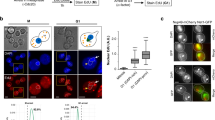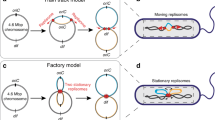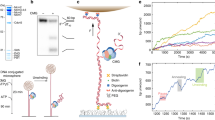Abstract
THE study of replication in higher eukaryotes has been hampered by the large size of the DNA molecules in their chromosomes. The yeast Saccharomyces cerevisiae is a eukaryote with very little DNA per haploid nucleus (9 × 109 daltons)1. This has facilitated measurement of intact yeast chromosomal DNA by sedimentation velocity2 and electron microscopy3. The results indicate that yeast chromosomes are similar in size to those of viruses and bacteria, each chromosome containing a single DNA duplex ranging from 108 to 109 daltons. More than 95% of the chromosomal DNA molecules isolated from asynchronous cultures are simple linear structures, but the few branched structures are good candidates for replication intermediates3. We have used two experimental approaches which provide evidence that these exceptional molecules are, indeed, replication intermediates. Characterisation of these molecules by electron microscopy indicates that yeast DNA replication is similar to higher eukaryotic DNA replication in two important respects. First, most and possibly all initiations are internal. Second, many chromosomes contain more than one replication unit.
This is a preview of subscription content, access via your institution
Access options
Subscribe to this journal
Receive 51 print issues and online access
$199.00 per year
only $3.90 per issue
Buy this article
- Purchase on Springer Link
- Instant access to full article PDF
Prices may be subject to local taxes which are calculated during checkout
Similar content being viewed by others
References
Hartwell, L. H., A. Rev. Genet., 4, 373 (1970).
Petes, T. D., and Fangman, W. L., Proc. natn. Acad. Sci. U.S.A., 69, 1188 (1972).
Petes, T. D., Byers, B., and Fangman, W. L., Proc. natn. Acad. Sci. U.S.A. (in the press).
Ogawa, T., Tomizawa, J.-I., and Fuke, M., Proc. natn. Acad. Sci. U.S.A., 60, 861 (1968).
Schnös, M., and Inman, R. B., J. molec. Biol., 51, 61 (1970).
Delius, H., Howe, C., and Kozinski, A. W., Proc. natn. Acad. Sci. U.S.A., 68, 3049 (1971).
Dressler, D., Wolfson, J., and Magazin, M., Proc. natn. Acad. Sci. U.S.A., 69, 2682 (1972).
Davis, R. W., Simon, M., and Davidson, N., Methods in Enzymology, 21, 413 (1971).
Lang, D., J. molec. Biol., 54, 557 (1970).
Inman, R. B., and Schnös, M., J. molec. Biol., 56, 319 (1971).
Wolfson, J., and Dressler, D., Proc. natn. Acad. Sci. U.S.A., 69, 2682 (1972).
Bücking-Throm, E., Duntze, W., Hartwell, L. H., and Manney, T. R., Expl. Cell Res., 73, 99 (1973).
Hartwell, L. H., J. Bact., 104, 1280 (1970).
Huberman, J. A., and Riggs, A. D., J. molec. Biol., 32, 327 (1968).
Callan, H. G., Proc. R. Soc., London, B, 181, 19 (1972).
Cairns, J., Cold Spring Harbor Symp. Quant. Biol., 28, 43 (1963).
Bode, H. R., and Morowitz, H. J., J. molec. Biol., 23, 191 (1967).
Author information
Authors and Affiliations
Rights and permissions
About this article
Cite this article
NEWLON, C., PETES, T., HEREFORD, L. et al. Replication of Yeast Chromosomal DNA. Nature 247, 32–35 (1974). https://doi.org/10.1038/247032a0
Received:
Revised:
Issue Date:
DOI: https://doi.org/10.1038/247032a0
This article is cited by
-
Yeast and mammalian replication intermediates migrate similarly in two-dimensional gels
Chromosoma (1995)
-
„Artifizielle“ Chromosomen
The Science of Nature (1987)
-
Replicon size of yeast ribosomal DNA
Molecular and General Genetics MGG (1984)
-
The regulation of mitochondrial DNA levels in Saccharomyces cerevisiae
Current Genetics (1982)
-
Isolation of chromosomal origins of replication in yeast
Nature (1980)
Comments
By submitting a comment you agree to abide by our Terms and Community Guidelines. If you find something abusive or that does not comply with our terms or guidelines please flag it as inappropriate.



